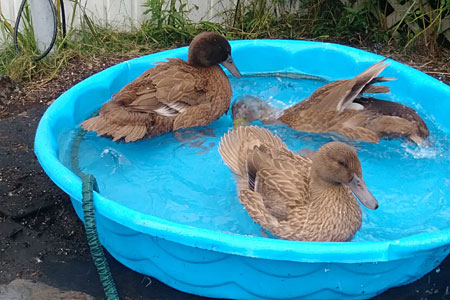
The Khaki Campbell duck came about when Adele Campbell of Gloucestershire, England, wanted a dual-purpose duck that laid well, but with a good-size body for roasting. The resulting duck breed first appeared in the late 1800s.
The ducks’ buff-color plumage reminded Ms. Campbell of army uniforms, hence the name Khaki Campbell. Introduced to the United States in 1929, the Khaki Campbell duck was admitted to the American Standard of Perfection in 1941.
Physical Attributes
Khaki Campbell ducks have a somewhat upright posture. Their bill is green and eyes are dark brown.
The drake has a dark brown-bronze head and tail. His upper plumage is a warm khaki, while the underside is khaki-tan. The drake’s legs and feet are orange.
The hen is a more muted seal brown with some penciling or lacing. Her legs and feet are dusty brown.
Males may be identified by their curled drake feathers. Another distinguishing feature of the Khaki Campbell drake is his rich brown head, compared to the hen’s paler khaki-colored head.
Khaki Campbells are slow growing. The hens mature to 3½ pounds live weight, the drakes to 4½ pounds.
Breed Qualities
Khaki Campbells are prolific layers. The hens begin laying at 5 to 7 months of age. They average 165 to 210 medium to large eggs per year. The shells are usually white, although some Khaki Campbell ducks produce eggs with pale green shells. The hens will brood, and are good to fair at mothering.
Khaki Campbell ducks are energetic and somewhat excitable, but will become genial toward humans if handled as ducklings. They can fly, although they rarely do. They are active foragers, making them easy keepers.
The Khaki Campbell is adaptable to a wide range of climates. So, regardless where you live, if you are seeking a fine looking, friendly duck that lays well, check out the Khaki Campbell duck.
Helpful Links
- Keeping Ducks for Eggs
- How to Keep Your Ducks Laying Well
- How the Eggs of Chickens, Turkeys, Ducks and Geese Compare
- How to Handle Duck Eggs for Eating
And that’s today’s news from the Cackle Coop.
Gail Damerow is the author of An Absolute Beginner’s Guide to Raising Backyard Ducks : Breeds, Feeding, Housing and Care, Eggs and Meat.

